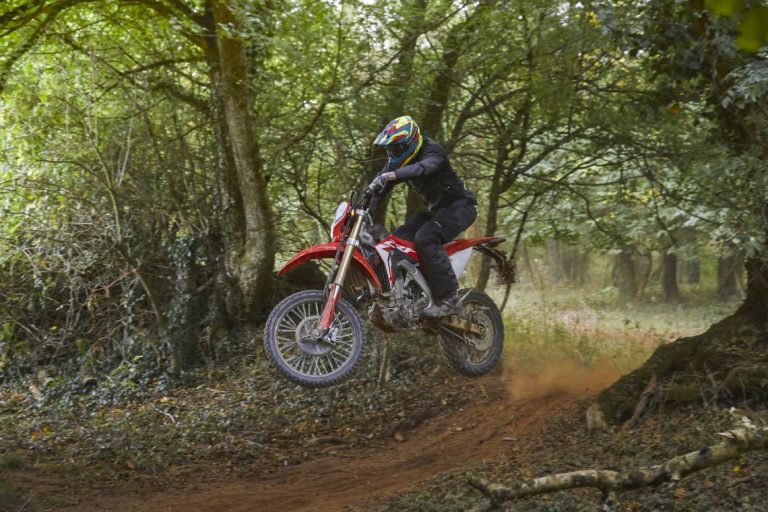Honda’s new 450 trail bike is being billed as the perfect Green Laner, but does it cut the mustard? Llewellyn Sullivan-Pavey finds out…
In 2005, Honda unveiled its very first full-blown, competition-style 450 enduro/trail bike, the CRF450X. The Japanese brand left it almost untouched for 13 years. In that time, the motorcycle marketplace changed a huge amount. KTM went on to dominate the enduro and trail segments while competition bikes and trail staples like the DR-Z400 faded into oblivion.
The CRF450L is here to fill a void that desperately needed filling. The dedicated trail bike market has been in a strange place for a long time. Nestled on one side of the fence you’ll find the ‘competition’ based motorcycles. These are your European enduro weapons from KTM, Husqvarna, Sherco, Beta and Gas Gas. They’re dedicated to going fast.
On the other side of the fence sits the softly spoken, lower-priced machines such as Honda’s CRF250L and CRF250 Rally, or the Beta X-Trainer and KTM’s great but flawed Freeride range. The core problem with most of these bikes is the compromise. They’re either over-biked and over-engineered for trail riding or sacrifice some peak chassis and design performance to be produced for a more attractive price.
So, what happens when you throw those ideas and place a bike squarely in the middle? You get the all-new CRF450L. When Honda announced the CRF450L in the summer, the internet lit up with excitement about the first new Honda enduro machine in a long time.
The announcement said it was based on the CRF Motorcross platform and would carry the same base chassis, suspension and engine with modifications to make it trail or dual sport friendly.
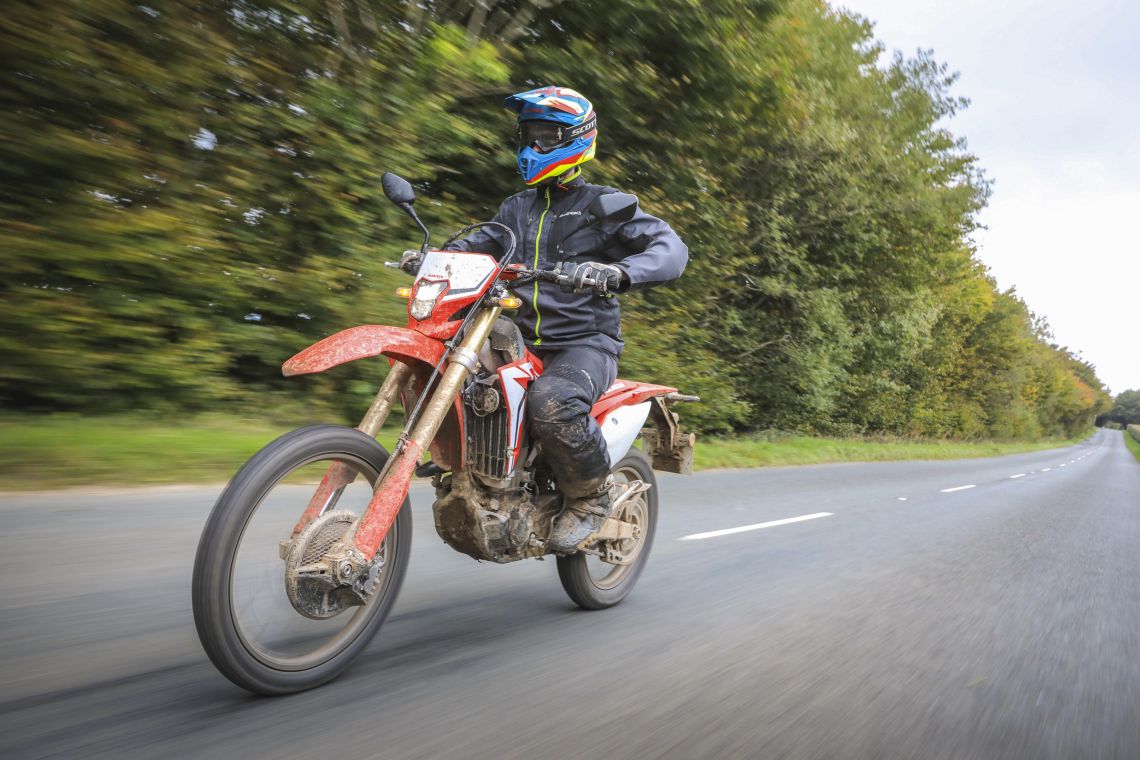
Except the CRF450L isn’t a street-legal re-tuned motocross bike. It’s not a rival to the KTM EXC either, in fact it’s not even close to being a competition enduro machine. Instead Honda has gone down the path of building what it believes is the ultimate trail bike.
The CRF450L is a trail bike through and through. It’s designed to be a machine for casual, relaxed riding on a great chassis with great suspension. Therein lies a huge distinction.
On paper, it doesn’t sound all that impressive. It makes the exact same peak power as the little CRF250L and that sounds like someone in the engine department made a catastrophic design error.
After all, any time you take an engine and chop 30hp out of it, no one gets excited. Yet, in doing so, Honda has made one of the best, dedicated trail bikes we’ve seen since the XR400 and CRM250 graced dealerships in the 90s.
Technical Specs
Honda started with its CRF450R motocross bike as the base for the L. It stripped the engine back and re-designed the internals. The 450 was fitted with a lower compression piston from the MX version, a six-speed gearbox and a crank with more mass for low RPM rideability. Honda has also revised the valve-timing to suit a more trail-friendly response.
One of the key points of the modifications is an extended service interval. Honda has drawn out the oil change interval to 1000km (600 miles) and 30,000km (18,500 miles) before any solid engine work.
The chassis has also been on the end of some trail riding specific alterations. The main difference to the MX bike is the wheelbase. Honda extended the bike, which improves stability at speed. The suspension uses the same high-end 49mm Showa forks and Showa rear shock, with a trail-specific setting.
The rear wheel has been swapped to the enduro standard 18-inch and the fuel capacity has been increased to 7.6L. The CRF also comes with an ignition switch, steering lock and locking fuel cap.
You’ll find a neat digital speedo nestled behind the headlight that provides a fuel readout in litres remaining and a fuel warning light that pops up with a healthy 2.5L left in the tank. The last set of alterations that make the 450L unique are in the sound dampening department.
As well as a whisper-quiet exhaust system fitted with a catalytic converter for Euro 4 emissions, Honda has also included plastic engine case protectors that double as sound dampeners. Lastly, the extruded aluminium swingarm has been filled with polyurethane to reduce the sound of chain slap.
All of that tips the scales at 130.8kg, wet and ready to ride. It’s not the lightest dirt bike in existence, but it’s far from offensive in the trail segment.
The Ride
The first thing that strikes about the CRF450L is the ergonomics. Using a full-blown dirt bike as the base for a trail bike has resulted in very little ergonomic change. That means it’s outfitted with a slightly lower than standard 940mm seat height and a long, hard seat.
The seat is made for riding, not replacing your couch with, and it feels that way. While it’s not a KTM EXC marble slab of years past, it’s not like the big, plush bench seat of a CRF250L or a touring bike. Ergonomically it is a dirtbike.
It’s tall, skinny and purposeful. Behind the slimline, ‘mass centralised LED headlight’ you’ll find a simple, effective digital speedo with a few notable features. The best of these, without question, is the ‘fuel remaining’ counter. Instead of providing a gauge or just a fuel light like most enduro machines, the Honda tells you, in litres, how much fuel you’ve got left and, when you’re out riding, that’s surprisingly useful.
Prodding the starter gives life to the mellow-sounding, quiet engine. It’s immediately apparent that any barky note that once rasped from the exhaust has been muted and shut down. Rolling down the country lane from the Dave Thorpe Honda Off-Road Centre, the whole CRF450L experience became immediately apparent. On the street, the ride is mildly more pleasant than any other enduro bike I’ve had the pleasure of swinging a leg over.
Honda’s large efforts to make the bike a whisper-quiet, trail-friendly machine have paid dividends. As well as having a quiet exhaust note, the CRF450L has very little resonance noise. It’s a nice touch that is undoubtedly a good thing for motorcyclists’ reputation.
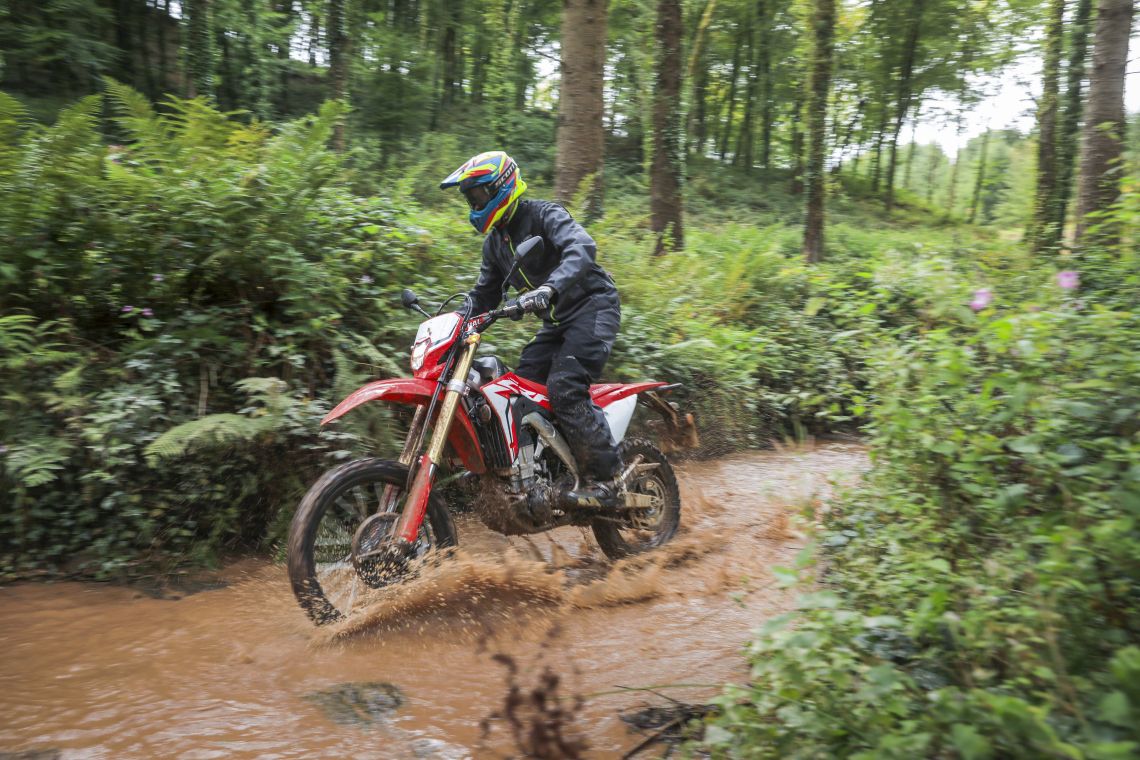
On top of being quiet, the more dual sport orientated tyres are more pleasant and safer on the tarmac than the FIM enduro-style tyres you find on most dirt bikes. The cornering is more predictable and the sense of impending doom that dirt bike tyres bring is no more. The whole street riding experience is still a chore compared to more street orientated bikes like the CRF250L.
Ultimately, the dirt bike chassis is extremely focused on one task and the moment the pavement turned to dirt that became clear. The key to this is that the CRF450L is a phenomenal bike to ride off-road. What Honda has achieved is a bike that will work well, regardless of your ability level and experience. That starts with the chassis. The biggest compromises with typical trail style bikes are in the potential of the bike.
By making equipment cheaper, corners get cut and the CRF250L is a great example of such a bike. It’s a solid trail bike with a limited performance ceiling that, as a rider tries to progress, will hold them back. It’s not a bad bike, but it’s got some price-related flaws.
The CRF450L has lost nothing in the translation from the motocross track to the trails. The whole package is a blend of performance and friendliness that hasn’t existed in recent times.
The chassis sits at the heart of this. Its full-blown, off-road nature means that it can take you from complete novice to an expert level rider and it’ll never hold you back. Like most Hondas, there is a very neutral feeling about the handling of the bike off-road.
It’s not the sharpest dirt bike, it’s not the quickest turning and there is a little more weight to it than the Austrian-based rivals but it’s beautifully balanced and purposeful. It’s sharp and effective in a way that trail bikes aren’t.
It handles ruts with precision, turns like a well-balanced dirt bike should turn and doesn’t tie itself in knots. A large portion of that comes from the suspension.
A win for the 450 is Honda’s decision to use the same high-quality suspension found on the MX bike, with a different internal setting. By doing this it’s given the CRF450L a great starting point that 85% of riders will never mess with. The standard suspension setting is progressive and effective.
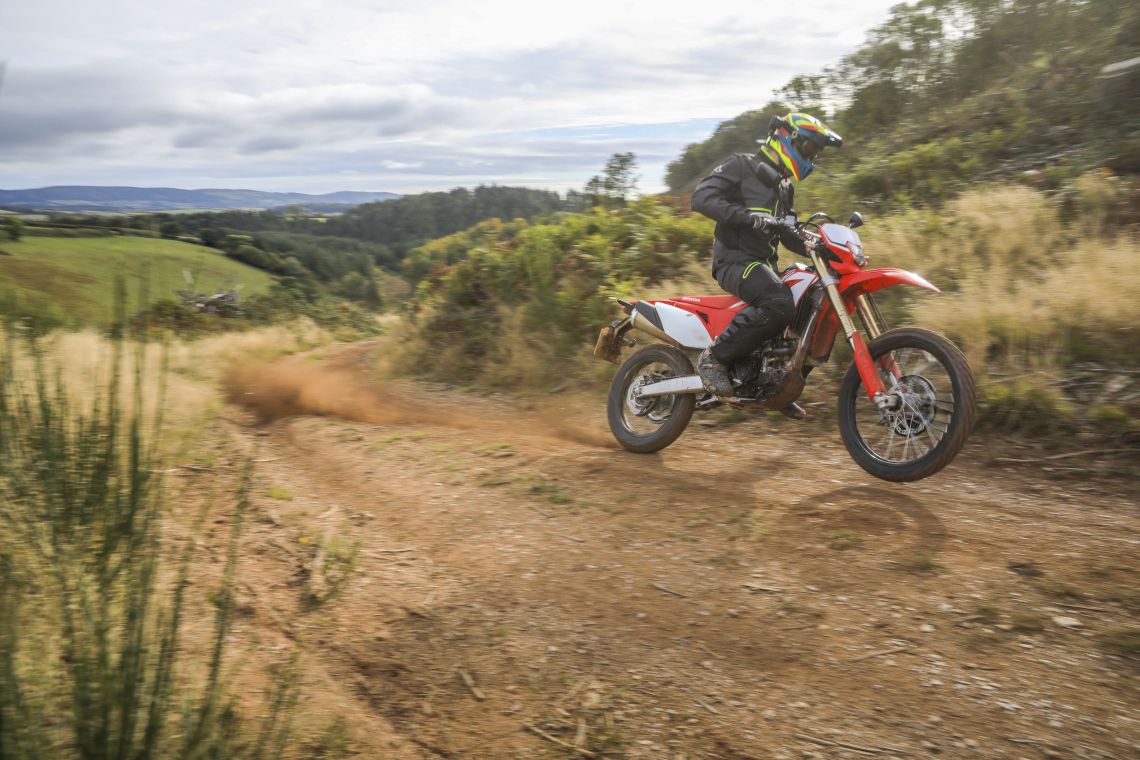
It’s definitely on the firmer side in comparison to most enduro and trail bikes. A little general comfort has given way to a slower and more controlled valving action. As a base setting, it works very well. Nothing untoward happens when you catch a big hit unexpectedly and over smaller, nibbly roots and bumps the Honda manages well. For someone of my weight (90kg), the Honda is slightly under sprung.
It sat a little low in the suspension stroke, which translated as a being a little harsh on small bumps. Generally, this wasn’t a huge issue and, even at speed over rocks, the Honda was stable and consistent.
Upping the spring rate front and rear will likely improve the initial plushness and comfort, but the overall balance was good enough that it wasn’t a deal-breaker. And that brings us to the engine.
Honda’s decision to chop a load of peak power out of the 450L is undoubtedly controversial. It’s producing exactly the same peak power as the 250L and yet, it couldn’t be more different to ride.
From the middle of the rev-range upward, the 450L is a flat bike. It’s linear, a little restricted, though all the better for it. At lower RPM, where most trail riding is done, the Honda is smooth and has a really healthy punch of torque.
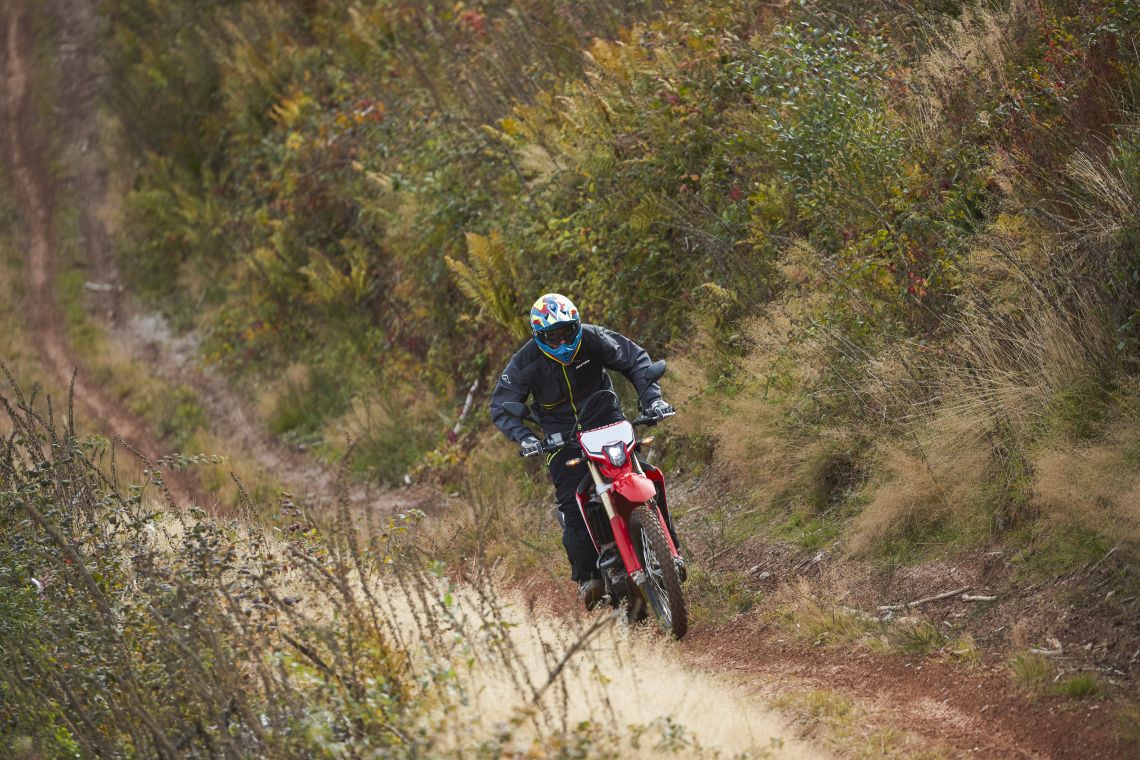
It’s strong from the bottom and drags you forward surprisingly quickly. Somehow the combination of lots of torque with a mellow mid-range and a flattened out top-end have made the CRF engine incredibly easy to ride. It makes dragging yourself out of trouble, climbing hills, being in the wrong gear and doing all things a trail bike should be good at, a reality without ever forcing you into difficulty.
The engine is a great balance between the best bits of an enduro bike and a budget trail bike. It means that the CRF never feels like a bike you have to tame or hold back. Yet, when the throttle is wound on or the trail attacks, the CRF doesn’t lack the punch to deal with what’s in front of it. Honda prepared a tight, twisty track in the woods for one of the photo spots.
It’s the type of track that is typically a nightmare for a 450 enduro bike, where the torque and power hamper as much as they help. Incredibly, the CRF lets you ride and ride. It didn’t ever rip out my hands, it’s more of a swift progress maker of a bike and in a trail machine that’s a wonderful trait.
The CRF is an all-day riding machine that’ll look after you if you’re tired but still has enough peak performance baked in that it’ll only bore you if you’re trying to go flat out around a big empty field. It’s a first for any bike I’ve ever ridden and that puts the CRF in a very unique position.
In between the great chassis and rider-friendly, well thought out engine configuration, you will however find some imperfections. All of them are small and if you’re entering the trail bike market without having ridden other brands of bikes they’re not hugely important.
However, the first point of note is the components. The Honda, unlike its European competition, still has a cable clutch. It’s heavier than the KTM/Husky/Beta/Sherco brigade and in 2018 it feels unnecessary. It’s far from horrendous and a day of technical trail riding didn’t ruin my left hand, but it could be improved.
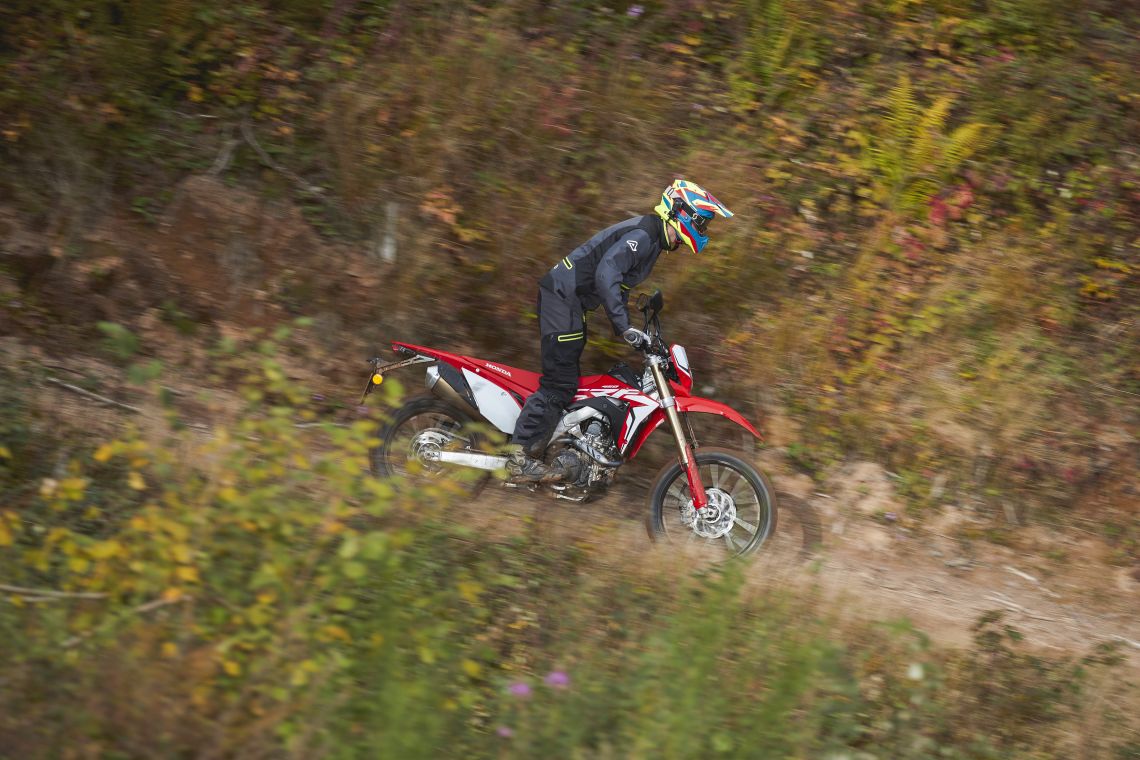
Second, on that component list is the Nissin front brake. It’s slightly wooden and a little less sharp than some of the Brembo competition. Personal preference has a lot to do with how much that matters. The brakes aren’t exceptional, they’re not abundant with immediate stopping force, but they’re more than good enough for the task at hand.
Price: £9,469
Engine: liquid-cooled, single-cylinder, four-stroke unicam
Displacement: 449.7cc
Maximum Power: 24.6 bhp
Suspension: Front; fully adjustable 49mm leading-axle inverted telescopic Showa coil-spring fork. Rear; fully-adjustable Showa single shock
Brakes: Front; 2-piston caliper hydraulic. Rear; 1-piston caliper hydraulic
Tyres: Front; 80/100 21-inch tyres. Rear; 120/80 18-inch tyres
Weight: 235kg (wet)
Tank Capacity: 7.6 litres
Tank Range: 110 miles
Seat Height: 940mm
Third on the component list is the use of a 7/8th sized handlebar. All the other bikes in the CRF range use a 1 1/8th inch handlebar and the reason for not going down this route is a little lost on us.
It’s not a deal-breaker but at the price point, it feels like a corner cut. The last question mark on the list was the tyre choice. As a trail tyre in places where the off-road grip is decent, the stock tyres feel like they’re a great option.
They’re infinitely more pleasant on the street than a full-blown Enduro spec tyre, however, the UK is not a place of decent off-road grip. On the test ride, where the ground was slippery and rutty, the tyre found its limit quickly. A lack of bite on the sidewall meant the tyre was more akin to a rudder.
A large portion of the first photoshoot segment was spent being unreasonably precise with line choice and hoping the front tyre found grip again before you crashed.
Conclusion and the price
At the end of a long day of enjoyable trail riding, the CRF450L left me with an extremely positive opinion. As a trail bike it is unique. The handling is extremely good, and the engine is useable and friendly for a much wider spectrum of people than most enduro bikes or trail/dual sport bikes are.
It’s incredibly focused at one task and it nails that task fantastically well. It’s important to understand that it’s essentially a friendly, street-legal dirtbike. It’ll be an unpleasant commuter and it’s not an adventure bike.
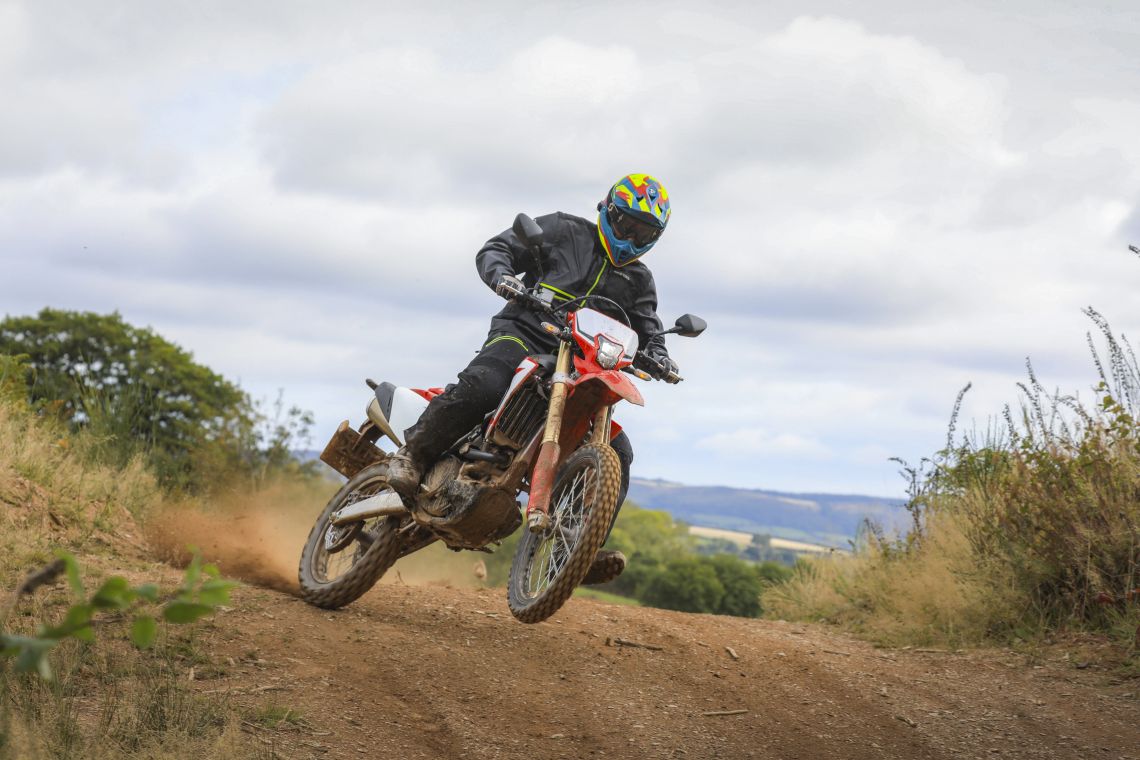
The street riding capacity is there purely to link the off-road together and that’s it. However, if you’re looking at dabbling into riding more off-road or you’re a regular trail rider, this is probably the best bike currently available.
The service intervals are better, it’s got a great warranty and the package is unique. However, the biggest hurdle is that it comes at a price. It’s more expensive than any other dedicated consumer off-road machine on the planet. If it’s the right bike for what you want and the price doesn’t make you choke then you’ll undoubtedly get a huge amount from the 450L.
Warranty
Dirt bikes typically don’t come with a warranty. It’s been the same since the dawn of time, bar a small blip when BMW produced the G450X and then purchased the Husqvarna brand. Once that moved to KTM the status quo returned. Most brands provide a few months parts warranty and that is that.
However, Honda has slotted the CRF450L under the banner of its ‘adventure’ range and bestowed it with a two-year, unlimited mileage warranty. It means the servicing and normal warranty things must be performed by your dealer, but it’s a big step from the Japanese brand.
Price Wars
The price is, without doubt, the biggest question mark over the new CRF450L. Honda has built a very specialised bike, but it has been given a price to match. A new model will set you back £9,469 inc. on the road. While you can’t deny a lot of development has gone into making the CRF a great trail machine, the competition is really strong.
KTM EXC 450 – £8,429 +OTR
Currently, the EXC is the king of competition 450 enduro weapons. It’s fast, incredibly light, smooth and handles fantastically. It’s also a full-blown competition machine, comes with a couple of months parts warranty and short service intervals.
Yamaha WR450F – £8,049
Outside of the UK, the WR450F has been one of the biggest selling enduro machines. our Aussie cousins can’t get enough of Yamaha’s flagship dirt weapon. For 2019 the Japanese brand has revamped the WR, with a host of updates. Like the KTM, it’s designed to be a competition machine first and foremost. It’s also non-EU4 homologated, so you’ll have to register it as a competition bike to be used on our roads.
Beta XTrainer – £5,795
The BETA XTrainer is a detuned, softer, smaller and more rider-friendly two-stroke 300cc play bike. Beta has developed a very clever oil injection system in the last few years that means the days of worrying about mixing two-stroke fuel are gone. The super-low weight and ease of use make the XTrainer a well-loved niche trail bike at a wallet-friendly price.
KTM Freeride 250 F – £7,199
The Freeride 250F is the most ‘trail bike’ machine in KTM’s lineup. Small, friendly, light and quiet, the KTM is a great little ride. They’ve improved durability and reliability since the bike launched as a 350F. It makes roughly the same power as the CRF450L.
Honda CRF 250L – £4,669 inc. OTR
The CRF250L is very much a bike built to a budget. It’s more dual-purpose than a focussed dirt machine, with some visible compromise on build quality and performance. It is still a great little trail bike, with an inoffensive engine and a low impact on your wallet. Will also last roughly one million years before it wears out.

